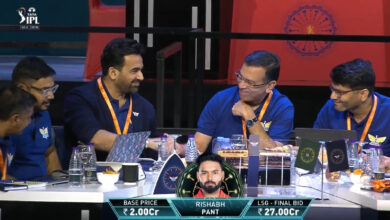How-to-bat in England manual for Rohit Sharma & Co in the WTC: Wait and leave the ball alone

Two years ago, swing and seam proved to be India’s bugbears in the World Test Championship (WTC) final against New Zealand. The four-pronged pace attack of Tim Southee, Trent Boult, Neil Wagner and Kyle Jamieson had left the Indians on the mat. In a couple of days time, the Rohit Sharma-led team will again be up against the likes of Pat Cummins and Mitchell Starc, who nonetheless are a notch better than their trans-Tasman rivals.
The age-old manual of how to bat in England is simple. Wait. But the Indians don’t do waiting, all that well. Especially when the ball swings around. The swing breaks their soul and about the time the ball starts to curve away or shape in, Indian batsman start to freeze. The balance starts to go topsy-turvy, the bat follows and there they break the thumb rule of batsmanship: Never play away from your body. It will be familiar territory for the Indian batsmen with the trajectory of the swinging ball winking at them.
Coming right after the IPL, the lack of preparation might hinder India’s chance to end their ICC title drought.
“Things are looking good but the only concern is that they have played so much T20 cricket in the past two months and for them to adjust quickly, that is going to be a challenge without having any match practice only four or five days of preparation. I am sure nowadays cricketers have learnt to make that switch very quickly with the amount of cricket being played, but it is going to be challenging,” former India opener Wasim Jaffer tells The Indian Express.
His views have been echoed former India captain and chief selector Dilip Vengsarkar, who feels “acclimatisation” is the key to do well in England.
“Acclimatisation is very important. It’s not like Asia, where you can adjust quickly. In England, it takes time,” says Vengsarkar.
Onus on openers
In the four Tests after the WTC final loss, India did well and was leading the curtailed series 2-1 against England. The reason behind India’s success was the way Indian openers Rohit Sharma and KL Rahul batted in that series. Rohit scored a match-winning 127 the last time India played at Oval. The knock came in India’s second innings when they were trailing 99 runs and it was an uncharacteric knock from Rohit, who faced 256 deliveries, spent close to five hours at the crease and hit only six. He, alongside the red-hot Shubman Gill, would want to whitewash the nightmare of Southampton, where they were undone the outswing in the first innings and late swing in the second.
Former India opener Wasim Jaffer says, “playing the new ball is going to be key.”
Shubman Gill playing a shot with Rohit Sharma at the other end. (FILE)
“Openers will have to play a massive role. England is the most challenging place to bat because of the sideways movement. Conditions change so drastically because of the weather. It changes quickly. The duke’s ball also poses a lot of problems. As the ball gets old, it will keep swinging and also starts to reverse. With Starc and Cummins, running at 145 kph, it is going to be challenging,” says Jaffer.
“Cummins will be a different beast with the duke’s balls. If the conditions will be slightly in favour of them, then they will make life miserable for the Indian openers.
“Rohit has got a hundred at the Oval, and Shubman is in great form across all the formats. Having a good opening stand is very massive in England. Openers will have to bat well and they would not want to expose their middle order. That was the problem last time in the WTC final. New Zealand’s pace bowling attack (Southee, Boult, Jamieson and Wagner) bowled so well. India doesn’t need to make that same make. Playing the first 30 overs is going to be key. If India doesn’t lose early wickets, then I think India has got a very strong batting line-up to negate the Australian attack,” he adds.
Dilip Vengsarkar has high hopes from Shubman Gill, and feels that the youngster’s time has arrived and he expects a big knock from the opener.
“He has got all the skills and the temperament. He plays cricketing shots and bats in the same way in all three formats. He needs to carry his form to the WTC.
“I really hope that he does well because he is very important for Indian cricket,” says Vengsarkar.
Adjustment is the key
Swing has always proven India’s nemesis. The old adage of Test cricket, “give the first hour to bowlers and dominate the rest of the day” doesn’t work when you are playing in England.
Vengsarkar says batting in English conditions is like playing chess. One bad move, and it is check and mate.
“There is movement in the air and also off the wicket in England. You can’t go for big drives; you need to push the ball. That’s the key. Wait for the ball; don’t go for an expansive drive unless it is really pitched up,” he suggests.
“The other thing about playing in England is that you can’t lose concentration, even if you are set, you just can’t afford to do that.
“During the sunshine, batting becomes good but the moment cloud comes in, the ball swings, and if it rains, it will make life difficult for the batters. You can get all seasons in one day in England. You need to bat very carefully till the very end,” says Vengsarkar.
The Virat template
Wasim Jaffer highlights the way Virat Kohli batted in 2018 as a perfect example of how to tackle the swing and movement.
Kohli had a terrible series in 2014, scoring just 134 runs in his 10 innings. But he came back to England an altogether different batsman in 2018 and finished the Test series as the top run-scorer with an impressive 593-run tally with two centuries and three fifties to his name.
Virat Kohli after scoring a ton. (FILE)
Jaffer points out the amount of balls Virat left was the key to his success in 2018.
“Even if you are batting at 60 or 70, suddenly one ball will come and can get you out. You can’t play away from your body in England. You need to be very sure of your off-stump.
“If you remember when Virat Kohli got all those runs in 2018 series, he left so many balls. This bowling attack will keep challenging you. They will keep bowling that fifth stump and sixth stump line, you need to be very sure which ball you want to play and which to leave. You can’t leave your bat hanging and must keep it close to your body,” says Jaffer.
Pujara, the white walker
When his teammates were busy with the slam-bang IPL, Cheteshwar Pujara was in whites playing county cricket in England. In eight innings he has played for Sussex, India’s No 3 has amassed 545 runs including three centuries.
Jaffer says no matter how many runs Pujara is going to score in the WTC final but given the scenario, he is the only one in this Indian cricket team, who has done the hard yards.
“Pujara is the only player, who is well prepared. He is playing county cricket since April and has scored runs as well. He is more prepared than anybody else,” says Jaffer.
Cheteshwar Pujar after scoring a ton for his county side Sussex (FILE)
Jaffer also believes playing against Australia has always brought the best out of Pujara. The right-handed batter is averaging 50.82 in 24 Tests he has played against the Australia. He has scored 2033 runs, including five centuries and eleven fifty-plus scores.
“Against Australia he has scored a lot of runs. He is a thorn in their flesh and they know how vital is Pujara’s wicket. He tires the bowlers out. Pujara doing well for India is a must and the good thing is that he is well prepared. What happens in the match is a different story but at least he has done the process,” says Jaffer.
Don’t sleep in the cordon
Besides suicidal batting tendencies, India’s cricketers had been afflicted with ‘butter fingers’, dropping easy catches. The ‘butter-fingered’ slip-cordon has cost India several Test matches in England.
“Slip catching is very difficult. The sightscreens are not that big in England. You don’t have the clear background. Dukes ball swings a lot, keepers face a lot of issues once the ball crosses the stumps. Same problem is with the slip fielders. The ball swings after taking the edge as well,” says Jaffer.
“Catching practice is going to be very crucial. They are coming on the back of IPL, where you don’t do slip catches anymore. But in England, slip catching becomes key. And then making sure slip cordon is very sure. Who is going to be at the first, second third and fourth slip,” he adds.
Jaffer hopes the Indian slip-cordon has done good amount of catching practice because, in a final, you can’t afford any slip-up.
“The cordon generally takes 70 catches daily. Individual catching sessions are also there if you are not in good catching form. It also depends on person to person,” he says.
Team combination
Horically Oval has been a good batting surface and it has more bounce in comparison to other English venues. Dilip Vengsarkar feels if there is no overcast condition, then India must play with three seamers and two spinners.
“Oval is a good batting wicket and it has got a good carry as well. There might be a possibility that India would play with five bowlers with two spinners in the team. If the conditions are overcast, they might go with four medium pacers and one spinner, given Ravindra Jadeja in the side as an all-rounder,” says Vengsarkar.







